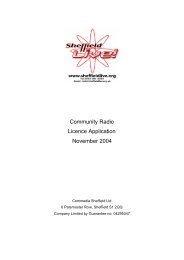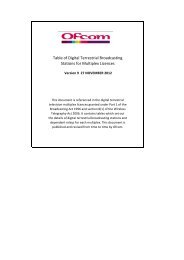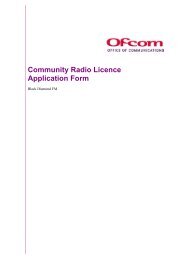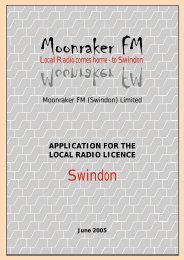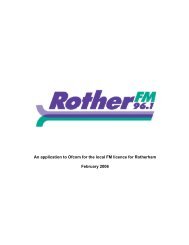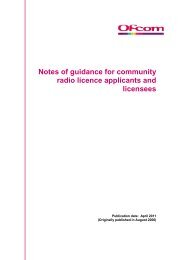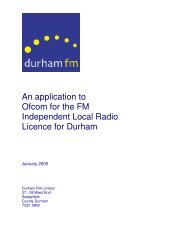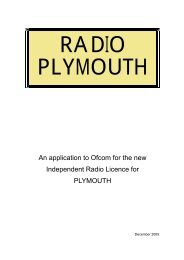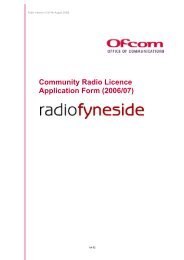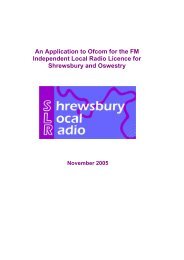UHF2 realignment study - Ofcom Licensing
UHF2 realignment study - Ofcom Licensing
UHF2 realignment study - Ofcom Licensing
Create successful ePaper yourself
Turn your PDF publications into a flip-book with our unique Google optimized e-Paper software.
240689 - 450-470 Study Final Print<br />
Version (Dec08).doc<br />
Table 15 Cost and Benefit Categories<br />
Cost/Benefit Category Method used to estimate value<br />
Direct costs of aligning the band Use PA Consulting 2004 report estimates, adjusted for<br />
inflation.<br />
Increased risk of service down-time<br />
during alignment<br />
Reduced customer demand during<br />
alignment as customers move to<br />
alternative suppliers<br />
Reduction in Continental Interference<br />
Management costs<br />
Increase in network efficiency as a<br />
result of less interference (i.e. Less base<br />
stations needed)<br />
Greater spectrum efficiency allowing:<br />
• Higher Govt revenues through<br />
further allocations of spare<br />
spectrum<br />
• New/improved services<br />
Standardisation and Harmonisation<br />
benefits<br />
• Lower equipment costs<br />
• New services available (such<br />
as European-wide roaming)<br />
• Adjust PA estimates by UK RPI for 2004-2007<br />
Use PA Consulting 2004 report methodology (adjusted for<br />
inflation)<br />
Use PA Consulting 2004 report methodology (adjusted for<br />
inflation)<br />
The reduction in interference will result in less expenditure in<br />
interference mitigation costs, which will be included in the<br />
network efficiency costs (below).<br />
ADTI/Mott MacDonald modelling of continental inference see<br />
Chapter 6. Account for infrastructure reduction and less<br />
reliance on alternative operator provided services. The<br />
assignments only affected by interference will be considered.<br />
Benefits over 15 years discounted to Net Present Value (based<br />
on a discount rate of 3.5%)<br />
Review of recent spectrum auctions in other markets (where<br />
appropriate) combined with using the equivalent value of<br />
spectrum based on Administrative Incentive Pricing rates..<br />
Estimate revenue per MHz for two service scenarios:<br />
• Narrowband services<br />
• Wideband services<br />
Assume that the value of additional spectrum freed up<br />
through band alignment is a proxy for the total producer and<br />
consumer benefits as a result of spectrum efficiency. No<br />
additional values are estimated for the impact of<br />
new/improved services.<br />
The value of efficiency benefits due to band alignment should<br />
be discounted to take account of the degree of spectrum<br />
efficiency that may occur in any case as a result of spectrum<br />
trading<br />
We assume the key benefits of standardisation and<br />
harmonisation are a 5% reduction in the average cost of a<br />
handset in the case of full band alignment. This is due to<br />
economies of scale of production as a result of full band<br />
alignment. This on the basis that (1) stakeholder interviews<br />
suggested little, if any, demand for services that leveraged<br />
spectrum harmonised with the rest of Europe and (2)<br />
technological progress means non-harmonised/standardised<br />
equipment no longer a major barrier to mass production etc.<br />
Page 79<br />
abc





